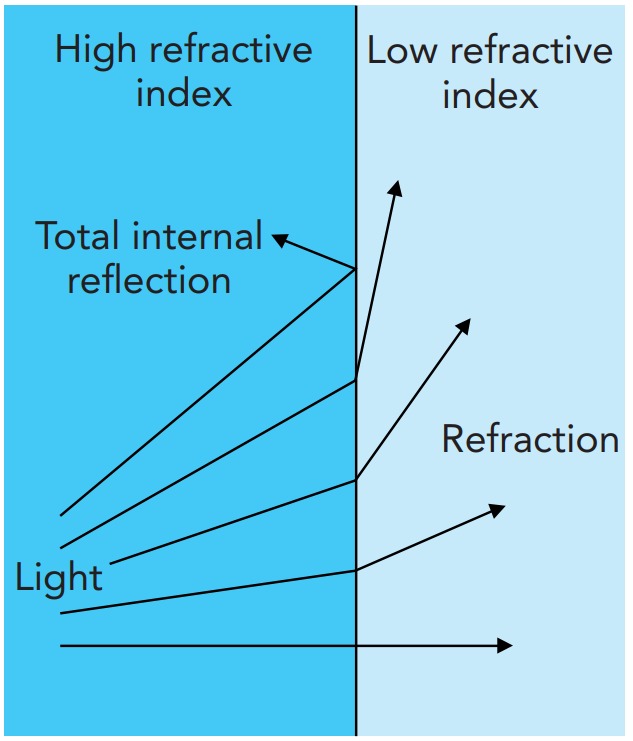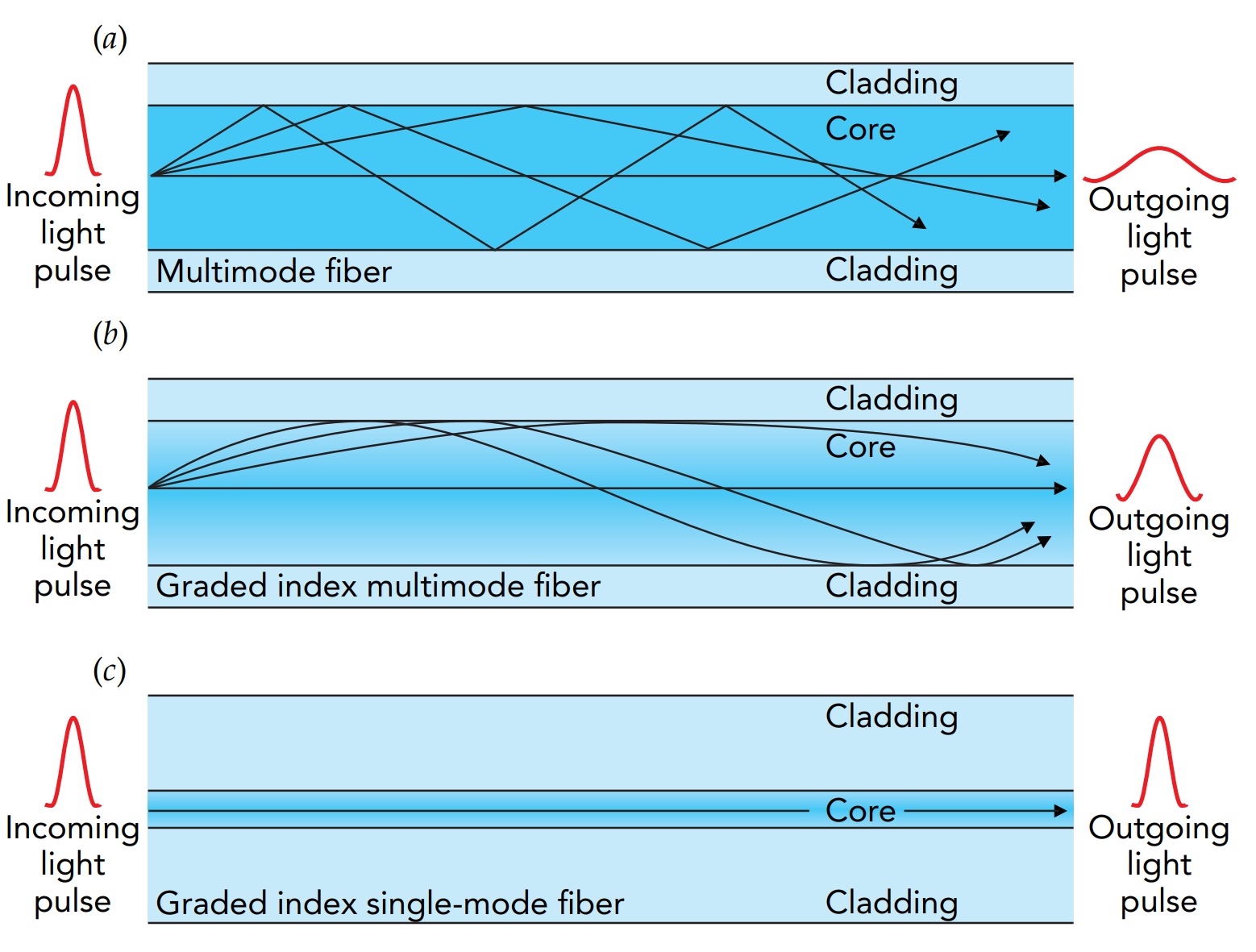Optical Fibres
Optical playback of prerecorded discs is fine for music and movies, but it isn't of much use when you want up-to-the-minute information. The Internet and World Wide Web require communication links that operate at lightning speed. Yet, even here, optics and light have an important role to play. The fastest way to send enormous amounts of information is to use optical fibers.
An optical fiber is a glass conduit that guides light from one place to another. Nearly every photon that enters the fiber at one end emerges from the other end moments later. In its simplest form, the fiber is made from two different glasses: a solid core of one glass surrounded by a cladding of the other glass. Both glasses are so incredibly transparent that light can travel through them for kilometers with little loss. For comparison, look through the edge of an ordinary piece of window glass and you'll see how dark the glass looks. It absorbs far too much light to be suitable for optical fibers. They're made of the purest glasses known.

If both glasses are almost perfectly transparent, what keeps the light from leaking out of the sides of the fiber? The answer is a phenomenon known as total internal reflection. As light tries to move from the inner glass core to the outer glass cladding, it's reflected perfectly and thus can't escape.
Total internal reflection is an extreme case of refraction. When light encounters the boundary between two materials with different indices of refraction, refraction causes that light to bend. If the material it enters has a smaller index of refraction than the one it leaves, the light bends away from a line perpendicular to the boundary. The amount of this bend depends on the two indices of refraction and on the angle at which the light approaches the boundary. As long as the approach angle is steep enough, light will succeed in entering the second material. However, if the approach angle is too shallow, the light won't enter the second material at all. Instead, it will reflect perfectly from the boundary. In fact, total internal reflection is far more efficient at reflecting light than a conventional metal mirror.
To keep the light inside the fiber's core, the core glass must have a higher index of refraction than the cladding glass. As light in the high-index core encounters the boundary with the low-index cladding, it experiences total internal reflection and bounces back into the core. As long as the fiber doesn't bend too sharply, the light bounces back and forth inside the core and can't escape. As a result, light entering the fiber core through one of its cut ends follows the fiber all the way to its other cut end.

A large-diameter fiber (typically 50 micro meter or more) has a problem. Light rays bouncing through it at slightly different angles travel different distances during their passage through the fiber. Light heading almost straight down the center of the fiber rarely bounces and takes less time to complete its trip than light that bounces many times. Because this wide fiber has many bouncing paths or “modes” in which light can travel through it, a short pulse of light going through the fiber gets stretched out in time. This pulse-broadening severely limits the rate at which information can be sent through a multimode fiber.
To reduce stretching problems, the core of a better-performance optical fiber has a graded refractive index. The core glass is specially treated so that its index of refraction decreases smoothly away from its center toward the cladding. Instead of bouncing abruptly when it reaches the boundary between core and cladding, light in this graded-index environment turns smoothly back toward the core. The path differences between the modes in a graded-index multimode fiber aren't so different, and a short pulse of light isn't stretched very much in a fiber of moderate length.
In very long fibers, however, even small path differences add up, and short pulses become blurred in multimode fibers. Therefore, the highest-performance optical conduits are single-mode fibers. These fibers have very narrow graded-index cores that permit light to travel only in one mode-effectively right down the center of the fiber. The core is typically only 9 micro meter in diameter. A pulse of light entering this narrow core broadens very little in time during its passage.
What little broadening occurs in a single-mode fiber isn't caused by the light taking different paths; it's caused by ordinary dispersion in the glass. To carry information, the light wave must change with time and thus must have a range of frequencies and wavelengths. As usual, the shorter wavelengths travel slower than the longer wavelengths and the pulses get stretched out in time. To minimize these dispersion effects, the highest-speed optical fibers operate at wavelengths that minimize dispersion. They also operate at wavelengths that minimize the loss of light through absorption in the glass. These two wavelengths coincide at 1550 nanometer in dispersion-shifted fibers, so this infrared wavelength is commonly used in long-haul optical communication.
Optical Communication
A typical optical communication transmitter uses a 1550-nanometer laser diode to generate short pulses of light. These pulses carry information from the transmitter to a receiver somewhere far away. The transmitter produces its pulses by varying the current passing through the laser diode. Light emerging from the laser diode is focused into the exposed core of a single-mode optical fiber, and it follows the core all the way to the other end of the fiber. When the light emerges, it's gathered by a lens and focused onto the receiver's photodiode. Each pulse of light causes a pulse of current to flow through the photodiode, allowing the receiver to begin processing the information.
A laser diode and a single-mode optical fiber can send billions of bits of data per second for 50 km or 100 km without significant errors. At longer distances, the gradual absorption of light in the glass makes it difficult to receive the information reliably. The easiest solution to this problem is to receive the data before the light becomes too weak and then to retransmit it with another laser diode.
Instead of interrupting the optical transmission with a receiver and retransmitter, some long-haul communication systems employ erbium-doped fiber amplifiers (EDFAs). An EDFA is a piece of optical fiber that has about 0.01% erbium ions in its glass core. When the EDFA is exposed to 980-nanometer or 1480-nanometer light, it becomes a laser amplifier for 1550-nanometer light. As the weakened pulses of light from a long fiber pass through the fiber amplifier, the amplifier duplicates photons and brightens the pulses. These amplified pulses then continue through ordinary fiber before being amplified again. Undersea optical cables often splice fiber amplifiers into the fibers every 50 km or so. These amplifiers allow light to travel thousands of kilometers through a continuous path, from one side of an ocean to the other.
To get the most out of a single optical fiber, many communication systems use several laser diodes operating at somewhat different wavelength ranges around 1550 nanometer. Light from these diodes is merged together and focused into the fiber. When the light emerges at the far end of the fiber, its different wavelength ranges are split apart and directed onto individual receivers. The different wavelength ranges are like different channels, so that this wavelength-division multiplexing allows one fiber to carry far more information than it could with light from a single laser. Remarkably enough, an EDFA can amplify all of these different channels at once because erbium ions can copy a wide range of wavelengths.